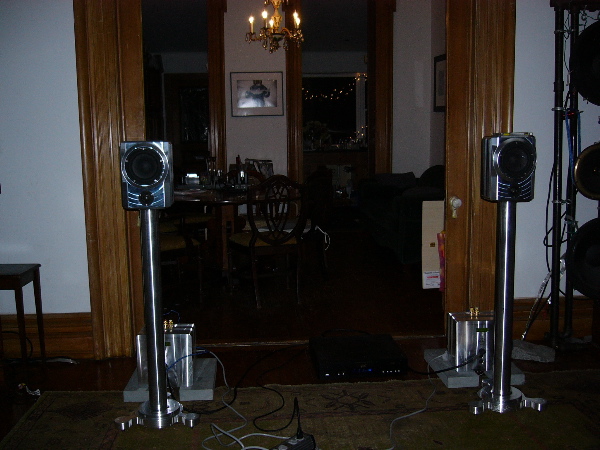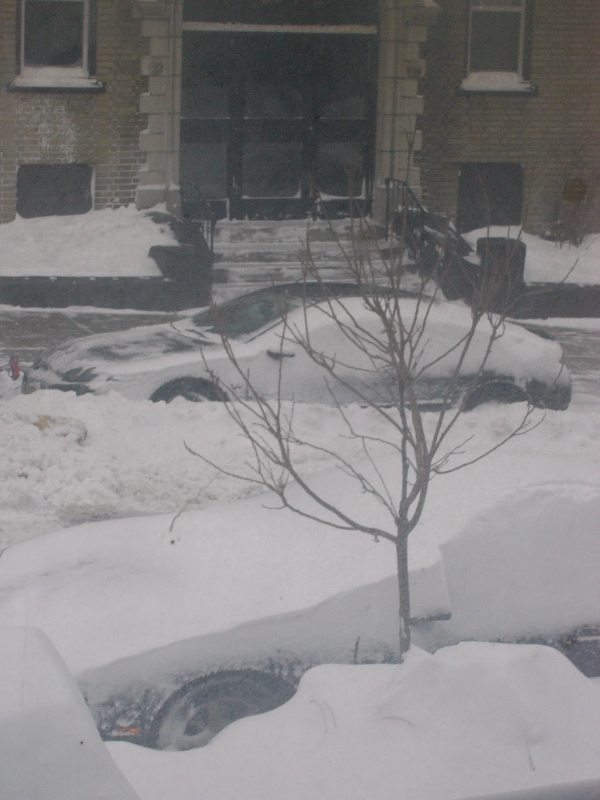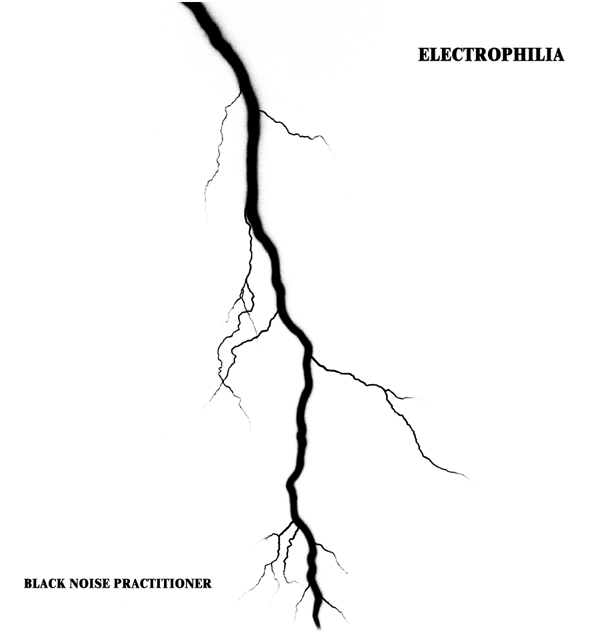Schwarz
View current page
...more recent posts
blown up blown out in bayside
joes new stereo
ipod mod
spacebox
(mocoloco)
saint marks place
![]()
if this wasn't a fake (alright simulated) architecture blog, these folks would be the competition. design sponge is particularly smarmy.
"For example, Grace Bonney, 23, works for a public relations firm that represents Vitra and other design outfits, and she acknowledged that she writes about some of her clients' products on her blog, Design Sponge (designsponge.blogspot.com), without disclosing that she is paid to promote them."

black on maroon
(ipod) filler up
(post edit: rip PJ)
go barbara boxer. here is some of the transcript from 1/18/05. essentially the lone rational voice in the rice confirmation hearings. she really built a sound case against rice piece by lucid piece. this is another under reported story in the conventional press. except from the right where she is characterised as rabid. i cant find any reporting (yet) of substance on boxers excellent work in yesterdays hearings in todays news / see 1/23 wolcott via moody - sign the boxer petition
too bad about johnny carson, 79 is pretty young. as far as talk show hosts go give me dick cavett or steve allen. but johnny had his place. on a good night the tonight show was as good as a bad the gong show. guests like buddy hackett, don rickles and monty rock the third could make for some fun tv party viewing. and those suits!
"At present, the single-family house is an erratic architectural pursuit. It is a product of patronage for the few. Developer cost-driven productions and popular taste in housing turn the masses elsewhere for shelter. Yet the architectural housing exercise still holds value. An opportunity for experimentation, domestic design has helped many renowned architects develop reputations. Ellwood modeled his practice on a distinct set of ideas, and actively marketed his ability to produce the commercially desired modern home."
(loudpaper)
utopian plagiarism
Critical Art Ensemble: Plagiarism often carries the weight of negative connotations (particularly in the bureaucratic class); while the need for its use has increased over the century, plagiarism itself has been camouflaged in a new lexicon by those desiring to explore the practice as method and as an alegitimized form of cultural discourse. Readymades, collage, found art or found text, intertexts, combines, detournment - all these terms represent explorations in plagiarism. Indeed, they are not perfectly synonymous, but they all intersect a set of meanings primary to the philosophy of plagiarism; they all stand in opposition to essentialist doctrines of the text: They all interpret that no structure within a given text provides a universal and necessary meaning. Consequently, one of the main goals of the plagiarist is to restore the dynamic and unstable drift of meaning, by appropriating and recombining fragments of culture. The pla! giarist sees all objects as formally equal, and thereby horizontalizes the plane of phenomena. All texts become potentially usable and reusable. Herein lies an epistemology of anarchy.
Merzbow - "Ananga-Ranga"
from the album Music for Bondage Performance.
Extreme Records (XCD008) 1994.
Arthur Kroker: The millennium is most certainly not the so lamented "end of history," nor a period of "post-history," but, most definitely, the beginning of recombinant history. We live, that is, at the edge of a fantastic intensification of a history that is yet to be written: the telematic history of the virtual body. It is a history marked by a double moment: its reflex, the archiving of the horizon of human experience into relational data bases; and its dynamic will, a will to virtuality, the creative recombination of our telemetried past into monstrous ("The will must be made monstrous"-Rimbaud) hybrids that will form the incisions of the electric landscape of the emerging century. Data trash? We are data trash, and it's good. Data trash crawls out of the burned-out wreckage of bodies splattered on the information superhighway, and begins the task of putting together the pieces of the (electronic) body together (again). Not a machi! ne, not nostalgia for vinyl, and most certainly not a happy digital camper, data trash is the critical (telematic) mind of the twenty-first century. Data trash loves living at that violent edge where total human body scanning meets an inner mind that says no, and means it. For who can now speak of the future of a postmodern scene when what is truly fascinating is the thrill of catastrophe, and where what drives on economy, politics, culture, sex, art, and even sighing is not the will to accumulation or the search for lost coherencies, but just the opposite - the ecstatic implosion of postmodern culture into excess, waste, and disaccumulation.
2.) Appropriation - The manner in which a recombinant element is handled as a discrete entity, that is, the changes or treatments which are applied to it in its movement from a preceeding context to a current one. Though the shift of contexts serve as the condition for this mode of recombination, the emphasis is on what specifically happens to the formal (and thus hermeneutic) properties of the specified and isolated recombinant element in that contextual shift. Changes in a recombinant text can be a matter of (recombinant) innovation and technique (as the OuLiPo has shown), and, for a certain situation, the appropriation of earlier techniques - avant-garde or not - can have varying effects depending on the text to be treated and the discourses involved. Appropriation may take place on the level of concepts/ideas/theoretical paradigms, on different formal bases such as linguistic alterations, formatting, or it may be based on a pastiche of outdated or traditional c! haracteristics such as genre, or individual (artist-based) and historical (period-based) style. The degrees to which appropriations are meant to be referential may also vary, from Joycean reference-games to indistinguishable mutations in Burroughs, each also varying the importance placed on the contexts from which an appropriation emerges (it may be less important to know which exact scientific article it is than to produce the effect of a scientific article, it may or may not be important that it is from a newspaper article, it may or may not be important that a certain author/text is being appropriated). Examples are any recombinant texts since this is but an emphasis on a fully interconnected phenomenon, but isolated examples include the Cabala (temura, notakarion, gematria), Tzara's "How to make a dadaist poem", as well as Burrough's treatments of specific texts (scientific/rehab articles, Rimbaud), and Acker's novels (diary, pornography, the myth of Rimbaud, sci-fi,/! /
Appropriation
Acker: What a writer does, in 19th century terms, is that he takes a certain amount of experience and he "represents" that material. What I'm doing is simply taking text to be the same as world, to be equal to non-text, in fact to be more real than non-text, and start representing text.
Sherrie Levine: In most cases it is reduced from the original but maintains the size of the book plate. The watercolors and drawings are traced out of books onto 11-by-14-inch pieces of paper. The paintings are easel-size on 20-by-24-inch boards. The pictures I make are really ghosts of ghosts; their relationships to the original images is tertiary, i.e., three or four times removed. By the time a picture becomes a bookplate its already been rephotographed several times. When I started doing this work, I wanted to make a picture which contradicted itself. I wanted to put a picture on top of a picture so that there are times when both pictures disapp! ear and other times when they're both manifest; that vibration is basically what the work's about for me - that space in the middle where there's no picture.
excerpted from :
Decay Heraclitus Velvet "Recombinant" [Textual Composition - Eugene Thacker]
(interview)
death by architecture online journal links
error message generator
(boingboing) (atom smasher)
"The iMac proved that consumers crave high design within economic reach. Architect Michael Graves achieved household-name status selling teakettles at Target. So when Robert Humble, AIA, and Joel Egan, Associate AIA, insist that prefab is about to take off because the public is demanding design sophistication in their housing as well as their shoes and MP3 players, it's hard to argue. “We see an opportunity to potentially influence design for the next century, and we mean to do it right,'' says Egan."
(cargotecture)
Yet through conversations with people familiar with the circumstances—including a student who witnessed the original incident—a picture emerges of a crisis that began on November 29, when in the course of a performance for a class taught by visiting instructor Ron Athey, a graduate student entered a classroom at UCLA's Warner building where roughly thirty other students were gathered. The student, wearing a coat and tie, produced either a gun or a convincing replica of one, put what looked like a bullet into the weapon, spun the cylinder, and held it to his head, Russian-roulette style. He pulled the trigger, but the gun did not fire. The student then left the room; while he was out of view, a shot was heard, at which point he returned, now apparently unarmed. A short discussion ensued between what the witness described as the "freaked-out" performer and a room full of people who were "a little frozen and a little scared," and then the class broke up for the day. This version of events expands upon but is basically corroborated by UCLA's official statement made by assistant vice chancellor Lawrence Lokman, who said that the performance "raised a number of important issues and concerns for faculty, staff, and students with regard to artistic freedom, safety, and the boundaries of performance art within an academic setting." He added that the dean of students office and the University of California Police Department were investigating to determine whether the student had used "an actual gun, or a replica."
bjork's new spike jones vid triumph of a heart
the physical appeal consumers quickly associate with design could "become more invisible, more transparent." In other words, you look through the design rather than at it and, it is hoped, register a product's appeal on a less conscious level.
hope my little trees survive
spaceface
"Recent archaeological excavations bring into focus a civilization that arose more than 5,000 years ago in three small valleys 100 miles north of Lima. Over more than a millennium, it spurred the development of more than 20 separate major residential centers. They are characterized by monumental architecture, large circular ceremonial structures, irrigated agriculture and housing."
h*ly-m*th*rf*ck*n'-sh*t!!!: brian reports the post report:
ROCK snobs, rejoice! Proto-punk legends the MC5 are joining forces with the eclectic Sun Ra Arkestra for a European tour. MC5 members Michael Davis, Wayne Kramer and Dennis Thompson will perform for the first time in nearly four decades with the Ar kestra, directed by Mar shall Allen. The su pergroup's special guest performers will include East Vil lage bar owner "Handsome" Dick Manitoba (The Dictators), Gilbey Clarke (Guns N' Roses), David Thomas (Pere Ubu, Rocket from the Tombs) and Lisa Kekaula (Basement Jaxx) [ not Basement Jaxx should read Belllrays]. The tour kicks off at Lon don's Royal Festival Hall on Feb. 25.
more DKT/MC5 details : here
north miami beach aqua: architectural kool-aid, just add water
"The lower parts of the mosque's walls are made of stone, with mud bricks above. Almost square in plan, the mosque has a flat roof, making it cubic in shape. Inside are six columns, four of stone dating from pre-Islamic times and two of brick. The columns divide the interior into four rows, leading towards the mihrab wall.
An elaborate coffered ceiling contrasts with the building's modest exterior. Most of it has survived intact since its original construction 800 years ago. The ceiling's twenty-two caissons are covered with intricate decoration carved, gilded, and painted in tempera. No speculative elements were inserted during the restoration. All new elements can be traced back to original examples in both their form and their location."
ownership society
Warhol had latched on to Basquiat as a career-freshening protégé and collaborator, and Warholian cunning informed the ultra-smart inventions of Neo-Geo, the milieu’s one launched movement that attained exit velocity, preoccupying the wider art world for a couple of seasons. Jeff Koons, the magus of an aesthetic that transforms commodities into art, which is then presented as the ultimate commodity, was overqualified for the East Village on arrival.
censorship and the golden age of animation
WFRR
(krys o)
ulm school section one section two
William Eggleston in the Real World. 2005. USA. Directed by Michael Almereyda. An intimate portrait of William Eggleston, who revolutionized color photography in the mid-1970s and who continues to conjure spellbinding images from the ordinariness of everyday life. "Peter Schjeldahl has written that Edward Hopper was ‘excited by the unguarded moment, the exposed innocence, of a person, a building, a place.' If you equate ‘innocence' with ‘mystery,' I think you can apply this to Eggleston, and to this movie about him" (Almereyda). 87 min.
at MOMA - Monday, January 17, 7:30. T2; Wednesday, January 19, 6:00. T1 (both introduced by Faggioni and Almereyda)
kiefer the seven heavenly places
(designboom-blog)
"In a meticulously planned mission that depended on clearing roadside trees by inches and covered more than 100 miles at a clip or a crawl from San Diego to a snowy, wind-battered mountain near Idyllwild, the oval-eyed, flying saucer-shaped structure has a new home."
miami lot house
KLH model eight

#BO.01: REBRAUN
MP3 JUKEBOX AND SERVER, 2002-2003
Vintage case, digital data, mixed multimedia, aluminium, acrylic, steel, liquid
crystal. CNC-milled, welded, thermoformed, lacquered, anodized.
Programmed with the VVVV MULTIPURPOSE TOOLKIT.
DIMENSIONS (WxHxD): 650x120x280mm
Designed in 1962 by Dieter Rams, the “Audio 1 Kompaktanlage” is a milestone of german post-war design. It embodies, even more than its predecessor, the famous “snow-white’s coffin”, the design ideals of the rationalist “Ulm School”. These sober paradigms of utility and matter-of-factness are playfully remodelled in the “ReBraun”: Two TFT-Displays take the place of the radio scales, the lettering on the anodised front plate ironically quotes the lingo of the radio era. A randomly positioned button, labelled “Zufall” (Randomness) stands for the freedom from mechanical constraints. The antenna does not receive any FM radio, but is used to connect the system to the internet via Wireless LAN. The case and acrylic hood were lowered by several centimetres for sporty reasons (think: hot rod!), and the window that formerly contained a signal strength readout now becomes a tabernacle for the old Braun nameplate.
victor papanek design for the real world
(tree hugger)
it seams like the last ten people i've talked to have all been watching allot of old movies on cable lately. AMC & TCM. almost all of them had just re-watched dr strangelove. me too. last night i watched fahrenheit 451 with the sound off and music on. now i have to check the schedule and watch it all over again with the sound on.
"The Fountainhead was published as a comic strip series in 1945 by King Features. The series included thirty comic strips illustrated by renowned illustrator Frank Godwin. The entire production of the original project was supervised by Ayn Rand, who also wrote most of the copy for the thirty installments."
Julius Knipl, Real Estate Photographer
bill owens: leisure
miami (wynwood) florida
"For a long time, Mayne ferociously resisted what he calls the ''con-tamination'' of his profession. He terrorized and alienated clients in his struggle to avoid the compromises that occur when drawings are converted into buildings. At 60, this former bad boy now finds that his firm, Morphosis, is winning some of the most prestigious commissions in the country. Even more surprising, he appears to have become the first-choice architect of the U.S. government, which, under the ''design excellence'' program of the General Services Administration, has retained Morphosis to build a federal office building in San Francisco, a courthouse in Eugene, Ore., and the satellite facility for the National Oceanic and Atmospheric Administration outside of Washington. All three projects are currently under construction. In New York, Morphosis recently won two important competitions: for the Olympic Village in Queens, which is a mixed-use waterfront development that is scheduled to go up whether or not the Olympic Games come to New York in 2012, and the art studio and engineering building of Cooper Union. ''It's really been a kick,'' he says. ''The last two major competitions in New York, I've gotten both of them.''
"On one side of the wall, a fresco of three birds hovers over the harsh fluorescent light of an emergency exit at the Institute for Military Geography. On the other side, a larger, ruined fresco sits at the foot of a Renaissance staircase in a 14th-century monastery."
you have reached the unoficial trailer park boys usa fan site
TPB -vs- SP video game
(episode guide)(the TPB board)
spite wall
top ten urinals
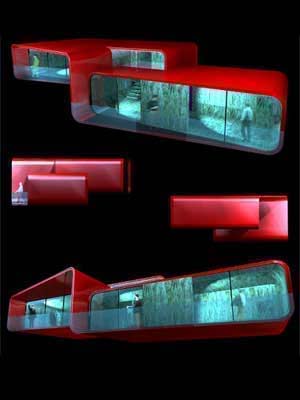
casa pR34
eurobad '74
the human clock
(boingboing)
the hang out
(mocoloco)
THURBER
Well, once I did a drawing for The New Yorker of a naked woman on all fours up on top of a bookcase–a big bookcase. She’s up there near the ceiling, and in the room are her husband and two other women. The husband is saying to one of the women, obviously a guest, “This is the present Mrs. Harris. That’s my first wife up there.” Well, when I did the cartoon originally I meant the naked woman to be at the top of a flight of stairs, but I lost the sense of perspective and instead of getting in the stairs when I drew my line down, there she was stuck up there, naked, on a bookcase.
"Two new and serious studies attempt the work of making Leonardo earthbound again. “Leonardo” (Oxford; $26), by the Oxford art-history professor Martin Kemp, is a summary of a life’s research; “Leonardo da Vinci: Flights of the Mind” (Viking; $32.95), by the biographer and historian Charles Nicholl, is a popular account, dense with social history and rational, high-hearted speculation. The simultaneous appearance of the books doubtless created two anxious publishers, but they complement each other almost perfectly: Kemp’s is Leonardo seen from the inside out, Nicholl’s from the outside in. Kemp explains Leonardo’s principles of design and his theory of the world from an intense knowledge of his mind and drawings; Nicholl shows where his ideas came from and who paid to subsidize them, through a broad rendering of his life and times."
ac danto on moma
The Miami Design Preservation League celebrates its 28th annual Art Deco Weekend with the theme "Art Deco and the New Deal." The event was created to raise awareness of the Art Deco era (roughly 1925-1945) and attract visitors to Miami Beach's historic district. South Beach no longer needs any added attention, but Miami loves any excuse to party. This year's festival salutes the Works Progress Administration (WPA), one of the "New Deal" government agencies that created public works in the Thirties. The WPA employed eight million people during the Depression and produced a stunning collection of literature, photography, art, and architecture. The weekend's schedule of films, lectures, and entertainment will give props to the WPA and its contributions to the Art Deco landscape of Miami Beach.
the great neon signs of las vegas
the relay project
"In the final section, "The Contextualized City -- A Computerized Symbiosis," we see contemporary visions of the future -- ever-grander projects, including "smart houses" controlled by computers. A foreboding thought is that these models may reflect the way we think we want to live, in the same manner the one-piece molded plastic room and modular houses represented the way people thought they wanted to live back in the 1950s. As someone who has suffered with a "unit bath," I would suggest we be careful what we wish for -- we might get it."
what happened to the architectects newspaper ? their online main page was last updated 11.16.2004.
ARTHUR DANTO
"Art Criticism After the End of Art"
Tuesday January 18 2005
Doors: 6:30, Lecture: 7:00
Space is limited, PLEASE email info@swissinstitute.net to reserve your entry
Arthur Danto is an American analytic philosopher and art critic who has spent the last half century teaching at Columbia University and has been an art critic for The Nation since 1984. In his role as philosopher, author, and art critic for The Nation, Arthur Danto has been a major shaper of recent aesthetic theory. He is best known for a contemporary version of Hegel's "end of art" thesis, first ennunciated by Danto in a 1984 essay called "The End of Art", and developed most recently in his After the End of Art (Princeton University Press, 1997). His numerous book credits include the 1990 National Book Critics Circle Award winner Encounters and Reflections: Art in the Historical Present and The Madonna of the Future: Essays in a Pluralistic Art World (2000).
"To further disconcert the public, the artists distributed a document which simply described the works displayed, refusing any commentary other than the “slogan” of the first event, which indeed had been staged with methods close to those used in advertising to launch a new product. The slogan was: “Buren, Mosset, Parmentier, Toroni are not exhibiting” (my emphasis). As Michel Claura would write during the fourth and last showing of this short-lived group, in the catalogue of the Fifth Paris Biennial in September 1967, for which the paintings reentered the galleries they had so hurriedly left a few months before: “Buren, Mosset, Parmentier, Toroni are the deliberate abandonment of sensibility, which has always been the attraction and driving force of art. All of Buren’s canvases – and the same holds for those of Mosset, of Parmentier, of Toroni – are identical. There is no more notion of perfectibility. Any search for an illusion would be in vain. A painting thus “reduced” is neither all nor nothing. Neither comfort or unease should be sought in these paintings. There is no communication. The spectator is left alone with himself. The contact with the artwork has lost its principle “quality”: its property as an emollient... The painting of Buren, Mosset, Parmentier, Toroni does nothing but exist.” [8] The four artists will separate on 5 December 1967.
Marcel Duchamp, who had witnessed the group’s third showing with some perplexity, passed away in October 1968, after having watched the students strike out against a society whose shortcomings he knew so well. The ideological agitation of Paris Spring had led to the creation of people’s studios at the School of Fine Arts and the School of Decorative Arts, whose productions are still on sale sometimes. No doubt more significant was the publication of Dubuffet’s book Asphyxiante culture [9] and of Jean Baudrillard’s Système des objets, is which consumption is defined as a “total idealist practice, which far exceeds our relations to objects and our relations among individuals, one that extends to all manifestations of history, communication and culture.”[10] These efforts to question habits of thought and vision, in which the world of representation counts for more than the representation of the world, could not help but lead artists toward more extreme avenues of research, allowing for a new apprehension of the artwork. At the same moment, Arte Povera was born in Italy with the action of Germano Celant, while in the United States, Joseph Kosuth and Mel Bochner were laying the foundations of “Conceptual Art”. One of the few French representatives of this latter group, Bernar Venet, himself lived in New York at the time, where he was creating mathematical diagrams."
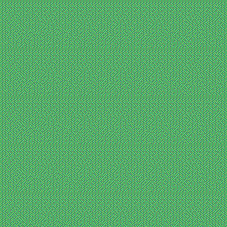
"Mosset moves to New York in 1977 and begins to paint monochrome paintings that deal with abstraction as silence, mutism and ineloquence. It seems that Mosset has reached a logical end point of painting, in the sense that it is difficult to imagine what can follow from his line of reasoning without crossing the line between art and non-art, excluding the thorny but brilliant interposition of Duchamp's readymade. This is perhaps not a unique occurrence in the history of art. Rodchenko's Red, Yellow, Blue or Ryman's white paintings are also logical end points. Mosset does not demarcate the limits of painting, however, because he has something fundamental to say about the process and result of painting, and is thus in some sense at the centre of it all, rather than at the edges.
chainsaw school of art
Eerie occurrences in a hugely popular computer game have been traced to rogue computer code accidentally spread between players like an infectious illness.
The Sims 2, released in September 2004, lets players assume godlike powers in a virtual community populated by characters they have created. They can influence the behaviour and fortunes of their characters in a huge variety of ways and sit back to witness the outcome.
The second edition of the game has already proven extremely popular and adds an extra dimension by enabling players to trade items, characters, even whole buildings through an online swap shop called The Sims 2 Exchange.
But in November 2004 several players began complaining that the characters and even some inanimate objects in their lovingly built worlds had begun behaving oddly. Some noticed that characters no longer aged while others found magical items - like an espresso maker that gives its user unlimited happiness - inexplicably installed in their character's homes.
[...]
"My dad had an acoustic guitar when I was a kid and it was an endless source of mirth in our household to start singing Hard Day's Night immediately after anyone dropped the guitar or otherwise accidentally strummed the open strings."
It was at Nagy's storefront gallery that Bleckner held his pivotal 1984 show, in which he displayed just one large painting, which combined text and abstraction. "There was a whole discourse about the process of making art the Halley and Ashley Bickerton and Sherrie Levine had reopened," remembers dealer Pat Hearn. "For Ross to use that painting was really clever." When Sonnabend Gallery brought together four East Village artist-Halley, Vaisman, Jeff Koons, and Bickerton-for its infamous 1986 "Neo-Geo" show, Bleckner's coterie was suddenly on top, and Bleckner, whose work was always more sensual than intellectual, more incidental than theoretical, ended up riding on the coattails of Neo-Geo, an aridly ideological movement rooted in half-understood ideas of structuralism.
JK: Neo-geo felt like every five years the art world wants a new art world, a new emergence, new artists. Was there really a neo-geo? I don't think so.
CS: I didn't think of it as appropriation, that idea hadn't crystallized at the time. All those ideas that came down, and continue to come down--I never really gave a thought to them until I read them. In the later '80s, when it seemed like everywhere you looked people were talking about appropriation--then it seemed like a thing, a real presence. But I wasn't really aware of any group feeling. It was a pretty competitive time. It wasn't just photographers or appropriation artists versus painters; there were so many different factions--the Mary Boone artists versus the Metro Pictures, the neo-geo...
my dad used to occasionally say "Dirty Rackafratz!" instead of cussing in front of us kids. there were only two google hits with "Dirty" included in the search and two pages for "Rackafratz" alone. no real leads on the origin. i have no idea where he got that from. he was a big Walt Kelly fan so it might of come from Pogo. I first came accross variations on &*?#@ in comics, probably Mad. could have started in krazy kat or prior.
affordable housing reader
RP: The "Joke" paintings are abstract. Especially in Europe, if you can't speak English.
S: That great White Columns show. It happened with the devotion and commitment of Eugene Schwartz, as curator, and the churning openness of Bill Arning, the director. Together we produced a show of high intensity and polemics that jolted and bounced in all directions. Fortunately the appropriationists were hanging out at the time, which gave me a whole new space for potent dialogue. This was very crucial, as it allowed entry into the work by negative definition--a valid, powerful position. Then again, the appropriationists made me a precursor, although refusing to be jammed into that category immediately put me back in hot water. The dynamic difference was that Sherrie Levine, leading the pack, brilliantly used the copy as a political strategy, whereas the force of my work lies in the premise that thought is power. What is currently compelling is our pervasive cybernetic mode, which plunks copyright into mythology, makes origins a romantic notion, and pushes creativity outside the self. Remake, reuse, reassem ble, recombine-that's the way to go.
JA: The big difference is that we had worn down one of the great experiences of that century, which was modernism. Maybe the label "postmodern" is overrated and doesn't mean much anymore, but nevertheless modernism was available to be consumed. You could extract its side effects and replay them however you wanted. In the '80s you would do that consciously. You were dealing with the fact that things had been made before. The '60s in a festive way-and the '70s in a more moralistic way--were a time when everyone was trying to make signature pieces, perfect inventions. That was gone in the '80s. You were just doing your thing and using what was available, but you were still quoting the sources. The difference today, when suddenly the '80s seem so "period," is that although younger people are still lifting and recycling, they just don't care about the sources. They don't even know about the sources. So they have another kind of freedom. But suddenly, for the those who try and twist it-and that's few of them, I wou ld say--the '80s are as distant as the '60s and '70s.
flatpack house
no time
As far as someone "appropriating" Mondrian, that is, I think, impossible.
And this impossibility is quite interesting. Mondrian, from around 1920 on,
is no longer an "author." Thus there is nothing to appropriate. He was
involved in a school called "the style," the object of which was, ideally at
least, to produce a totally anonymous art. He encouraged this, and became
upset when certain members of "de styl" deviated from his way of doing
things. There are, in fact, already a great many "Mondrians" painted by
others. Once, when given some advice in speeding up his extremely
painstaking methods, so he could be more productive, he answered: "I do not
need more paintings. I need to understand." I think Mondrian would be
extremely pleased that yet another artist would be interested in using his
approach. And, as a friend of Duchamp (there was mutual admiration here),
he would probably have understood her "need" to exactly duplicate one of his
paintings (if this in fact is what she has done). In any case, in my view,
Mondrian's work is undeconstructible, or, let us say, at least as
undeconstructable as that of Derrida.
correcting and adding to the record on : STEVEN PARRINO
Steve always had a neat studio. There was never a big storage closet full of older works. Although we were friends I never really caught him at work putting together those big scale piss elegant abstractions. I do know studio mates of his however who did spend time with him working who mentioned that he had a habit of either destroying, reusing (refucking-up) or painting over unsold pieces. Some of those canvas wads were old (often exceedingly successful ) stretcher pieces. Pieces in one show would be repainted, usually trending to black for the next show. I think he took a que and ran with it, as this is something (best friend and biker buddy) Olivier Mosset does too: repainting old pieces for new shows. This would suggest that there is precious little work(for someone with 37 solo shows) outside of the sold pieces. I'm hearing that Steve didn't keep much of a record of this process. That may make for something of a challenge in assembling his catalog raisonn'e. With any luck written and photographic gallery and museum records of works destroyed, transmuted and physically same (painted-repainted) paintings with different names, identities and meanings will form a convolutedly accurate history. I would hope that this important aspect is explored in Parrino's upcoming major survey show currently being planned by Geneva's Musee d'Art Moderne et Contemporain for October 2005.
note: Parrino's destruction of unsold paintings has a wholly different meaning from the destructive editing activities of precedential modernist's like de Kooning and Baldassari. This may have been fully obvious but is just dawning on me now, posthumously.
-Bill Schwarz
"Never really intended for construction, Living Pod was a humorous dig at the established way of doing things, suggesting that houses didn't have to be symmetrical, brick-built boxes. In its obvious debt to spacecraft aesthetics, it also seems to celebrate the possibilities of new technologies and new materials--an adaptable, functional, clip-together kind of future."
"Archaeologists uncover Mies van der Rohe villa
Archaeology is getting more modern—or rather, its uses are. The foundations of a villa built 1925-27 by the eminent Bauhaus architect, Mies van der Rohe, have been uncovered in the Polish town of Gubin. It was the first Modern building by the architect, commissioned by industrialist Ernst Wolf and destroyed in World War II. The excavation project was carried out by an international team of 12 students from the Technische Universität at Cottbus. The villa may now be partially rebuilt or used to inspire artistic interventions"
the sound sculpture of harry bertoia
Claude Oakland
Modern homes for the masses
"From its inception, modern architecture had a social conscience. Especially in the optimistic years after World War II, architects nationwide hoped they could build careers designing dwellings for everyman.
But almost none of them did. Many designed public housing, small tracts and homes for their friends in academe. But most whose careers remained residential ended up building primarily for the well-heeled."
[...]
digital programmable thermostat
"Here's a neat idea for a new television series. Let's get the public to nominate the six vilest books in the English language and in the grand finale, they get to burn them live on camera. No, we haven't come to that yet, but later this year, Channel 4 is offering us the next best thing. Demolition is a four-part series that promises as its climax the total destruction of a major piece of architecture. Or as Nick Kent, the executive producer, puts it: 'The final night of the series will see a spectacular celebratory demolition of one of the nation's nastiest eyesores.'"
Two works of Steven Parrino shown recently in Europe (Milano, Italy and Dijon, France) bring back home thoughts on that 20th century thing called abstraction.
Blob Fuckhead Bubblegum, a big ball of pink painted canvas (100 yards) tightened with duct tape, and Aluminum Clouds (Crush), for Drella (by the way, kiss my ass you wigged corpse) or Lost Hope and the End of Painting, which consists of a number of small bundles of silver painted canvas also held together with duct tape, seem to be an appropriate response to today's confusing pluralism in the arts. Painted monochrome canvases unattached and rolled into bundles clenched with tape - look like what you would do if you wanted to throw away some large, failed paintings. Of course, Steven Parrino didn't get rid of them, he is showing them.
By taking his paintings off the stretcher, rolling them into balls and putting them onto the floor, he is redefining a debate on the conventions of painting and that affair of the integrity of the picture plane. By destroying the surface and the shape of his canvases, he makes his paintings become a kind of sculpture, or more exactly something that is "neither painting nor sculpture." Because of the radicality of his gesture, he also sends the old debate about flatness or the problem of the canvas's outer edge to the dustbin of history.
We know that painting will not die (Philip Taaffe) or that it already died and we can't get rid of its corpse (Sherrie Levine); Parrino himself poses the situation: why not engage in some necrophilia?"
Of course, unstretched material has been seen before (antiform, Support-Surface, Sam Gilliam and others), but here the violent and aggressive dislocation of the picture seems to mark for painting something close to the end of the road. Maybe the only way you can pay attention to the surface of the picture is by destroying it ("Everybody kills the thing he loves").
Parrino's aggressivity in his work and his titles should be welcomed at a time when contemporary art is attacked directly (by certain members of the Congress and Senate) or indirectly (The New York Times, "The Jabberwocky of Art Criticism." Sunday, October 23, 1995). Of course what is really under attack is precisely those progressive attitudes like Parrino's that tend to question the nature of art.
Olivier Mosset
BOMB Summer 1996, No. 56
2004 top ten
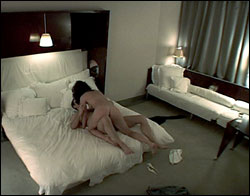
1 - wfmu top ten list
2 - andrea fraser from walter robinson's top ten list
3 - red states come out
4 - sherry levine continues to do mediocre work
5 - richard prince continues to do mediocre work (spot trend?)
6 - mediocre shipping container houses hit the nyc art scene and get a mediocre review in architects news paper
7 - frank lives in a drat hole on dave's page
8 - selma actually knows about art and architecture
9 - terminal five show from tom moody's top ten list
10 - my show of a ten year old piece (my first 1000 wrenches) in lori bortz's garage, a studio visit by bob nickas and palemale starts rebuilding his nest
addendum : bbca starts broadcasting trailer park boys south of the border

bootlegs
richard prince the second house
the science between earthquake and the sunami's landfall
clay house via houses of the future

